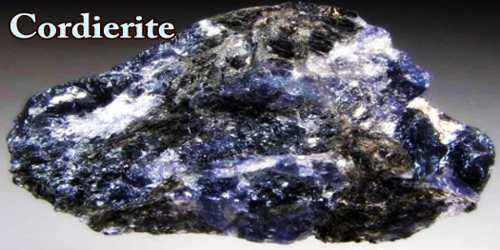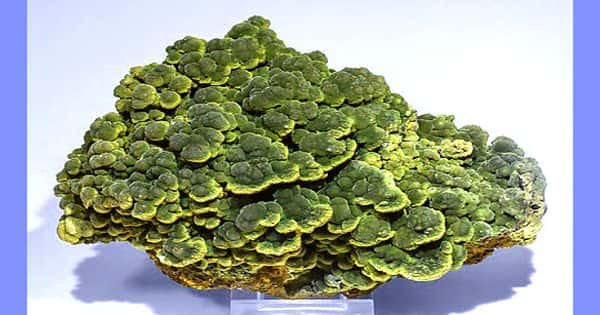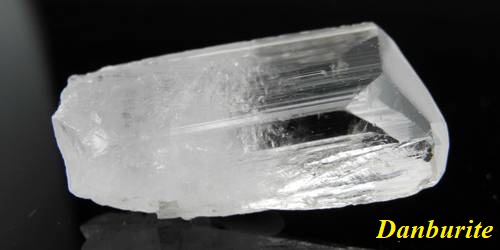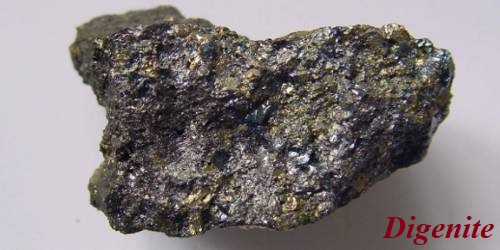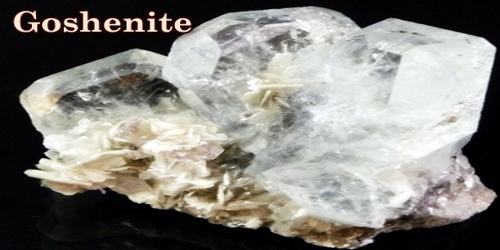Definition –
Cordierite (mineralogy) or iolite (gemology) is a silicate mineral that is found in metamorphic and igneous rocks. It is typically blue to violet in color and is one of the most strongly pleochroic minerals. It forms a solid solution series with the rare mineral Sekaninaite. Cordierite is the magnesium-rich end-member, and Sekaninaite is the iron-rich end member. Pure Cordierite without any iron present is not common. Cordierite has a chemical composition of (Mg,Fe)2Al4Si5O18 and forms a solid solution series with sekaninaite, which has a chemical composition of (Fe,Mg)2Al4Si5O18.
Cordierite, which was discovered in 1813, in specimens from Níjar, Almería (Spain) is named after the French geologist Louis Cordier (1777-1861). Cordierite often is replaced by other minerals, especially phyllosilicates such as micas, Chlorite, and Talc. An interesting and unique habit is the Muscovite pseudomorphs after Cordierite from Japan, which form glittering, flower-shaped trapiche crystals.
Cordierite (or Iolite) typically occurs in thermally altered clay-rich sediments surrounding igneous intrusions and in schists and paragneisses. Precambrian deposits of the Laramie Range, Wyo., U.S., contain more than 500,000 tons of cordierite. Cordierite is sometimes called dichroite because of its marked pleochroism (different colored light is transmitted in different directions).
“Cordierite” is a name used by geologists. When the mineral is transparent and of gem quality, it is known as “iolite” in the gem and jewelry trade. Two older names for the mineral are “dichroite” and “water sapphire.” The name dichroite means “two-color rock,” inspired by cordierite’s pleochroic property. The name water sapphire is also related to pleochroism. It was used because a specimen could have the color of sapphire when viewed from one direction, but if the stone was rotated it could appear to be as clear as water.

Occurrence and Properties of Cordierite –
Cordierite typically occurs in contact or regional metamorphism of pelitic rocks. It is especially common in hornfels produced by contact metamorphism of pelitic rocks. Two common metamorphic mineral assemblages include sillimanite-cordierite-spinel and cordierite-spinel-plagioclase-orthopyroxene. Other associated minerals include garnet (cordierite-garnet-sillimanite gneisses) and anthophyllite. Cordierite also occurs in some granites, pegmatites, and norites in gabbroic magmas. Alteration products include mica, chlorite, and talc. Cordierite occurs, for example, in the granite contact zone at Geevor Tin Mine in Cornwall.
Very large, altered Cordierite crystals once came from the Silberberg Mine, Bodenmais, Bavaria, Germany. Brownish-red to tan microcrystals are found in the Eifel Mountains of Germany at the Bellerberg volcano in Ettringen. Large, well-formed crystals of Cordierite with very good color were recently found in Søndeled, Risør, Aust-Agder, Norway. Also in Norway is Tvedestrand, Aust-Agder, where Cordierite occurs in a Quartz matrix.
Trapiche-shaped flowers formed from Muscovite pseudomorphs after Cordierite are well known from Kameoka City, Kyoto Prefecture, Japan. Gem-quality Cordierite is found in several of the Madagascar pegmatites, especially in the Tranomaro area, Tuléar Province. Gem crystals also occur in Babati, Manyara Region, Tanzania; and across the Atlantic at Virgolândia, Doce Valley, Minas Gerais, Brazil.
In the U.S., the most prominent localities are in New England. Large, opaque crystals of excellent form are found in a Talc quarry in Richmond, Cheshire Co., New Hampshire. Bluish-gray Cordierite has come from Haddam, Middlesex Co., Connecticut; and a deep blue Cordierite from Hungry Hill, Guilford, New Haven Co., Connecticut.
Cordierite is also found as an accessory mineral in granitic igneous rocks and in pegmatites. When crystals of cordierite have the opportunity to grow without obstructions, they can form short prismatic crystals with a rectangular cross-section.
In metamorphic rocks, cordierite is often found associated with sillimanite, kyanite, andalusite, and spinel. Most gem-quality iolite is produced from placer deposits, where it occurs in association with other gems even though its specific gravity is not high enough to cause a concentration. When exposed to weathering, cordierite alters to mica and chlorite.
Cordierite’s crystals, which are uncommon, are wide and stubby or prismatic. Crystals will usually form in a pseudohexagonal shape, and frequently have etches or striations. Cordierite is most often grainy, massive, and in unshaped fragments. It is also found as rounded water-worn pebbles.
Cordierite or Iolite has a Mohs hardness of 7 to 7 1/2, which is durable enough for many gems uses. Its main physical disadvantage is its distinct cleavage in one direction. This makes it vulnerable to breakage when used in rings or other items that could encounter rough use.
Clear cordierite is sometimes cut as a gem; the stones from the gem gravels of Sri Lanka have been called water sapphires. Synthetic magnesium cordierite has a low thermal expansion and is used as a semi refractory material because of its resistance to thermal shock.
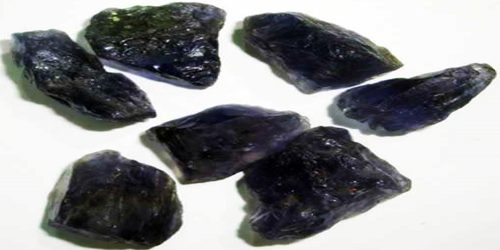
Uses and Benefits of Cordierite –
The transparent gem variety of Cordierite is known as Iolite and has recently become a mainstream gemstone. The name “iolite” comes from the Greek word for violet. Another old name is dichroite, a Greek word meaning “two-colored rock”, a reference to cordierite’s strong pleochroism. It has also been called “water-sapphire” and “Vikings’ Compass” because of its usefulness in determining the direction of the sun on overcast days, the Vikings having used it for this purpose. Due to its good color and hardness, it is used as an affordable replacement to Sapphire and is used in ring, earrings, and as pendants.
Catalytic converters are commonly made from ceramics containing a large proportion of synthetic cordierite. The manufacturing process deliberately aligns the cordierite crystals to make use of the very low thermal expansion along one axis. This prevents thermal shock cracking from taking place when the catalytic converter is used. However, synthetic cordierite is used instead because its supply is reliable and its properties are consistent. Many other natural materials are losing their place in the industry to synthetic materials for these reasons.
The most striking feature of Iolite gemstones is the pleochroism property that it has. The property is caused by an optical phenomenon by which the grains of a stone appear to have different colors when observed at different angles. Iolite predominantly displays both golden and blue colors.
Iolite is almost never seen in mass-merchant jewelry. It is a gem that is unknown to the average consumer because it is not being marketed. Jewelers do not order it or market it because they are not confident that an abundant supply of quality material will be available to support them. This is surprising because significant iolite resources exist in many countries. Its value in the gem trade has not been developed and thus its price is low.
Cordierite or Iolite enhances willpower and boosts motivational energy on all levels thus is a fantastic crystal to use for making focused and targeted changes in one’s life by eradicating old deeply immersed patterns. It brings order to chaos and instills a sense of self-confidence in one’s abilities and decisions made. The blue and golden rays that Iolite projects is fantastic for aligning one’s creativity and manifesting regions, especially in regards to transformation from debt to abundance!
Iolite energy can swiftly transform a pessimistic outlook, into a positive one instilling the knowledge that largely in life; one creates their own luck with positive thoughts and transforming creative ideas into a physical reality by way of pragmatic physical action! It helps give oneself a detailed understanding of addiction, which then greatly helps in releasing and overcoming it.
Information Sources:
